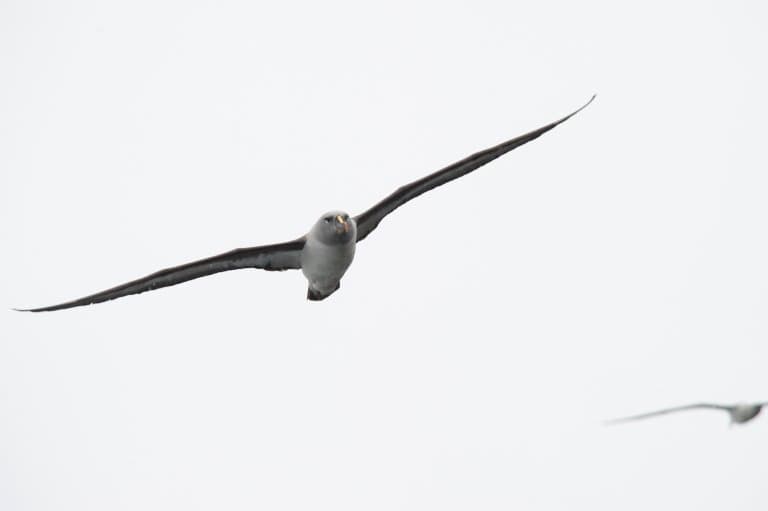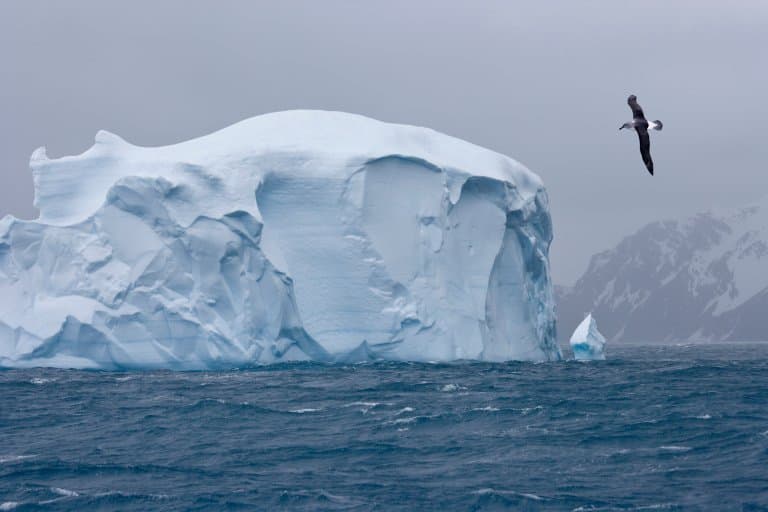Grey-Headed Albatross Profile
Among the incredible fauna of the Southern Ocean, little is as well-adapted to the inhospitable avian conditions as the albatross. Once thought to be the lost souls of dead sailors, it’s notoriously bad luck to kill one.
Yet, tens of thousands are killed every year by illegal or unregulated fishing trips. Most of those killed are grey-headed albatrosses, one of the world’s most accomplished travellers.

Grey-Headed Albatross Facts Overview
| Habitat: | Islands and open ocean |
| Location: | Subantarctic, polar |
| Lifespan: | More than 46 years |
| Size: | Up to 2.5m (8.2ft) wingspan |
| Weight: | 4.4kg (9.7 lb) |
| Color: | Grey/white with a black and gold beak |
| Diet: | Mostly squid, some crabs, lampreys and carrion |
| Predators: | None |
| Top Speed: | Possibly upwards of 127kmph (79mph) |
| No. of Species: |
1 |
| Conservation Status: |
Endangered |
The grey-headed albatross is a large seabird measuring up to 81 cm (32 in) in length with a 2.2 m (7.2 ft) wingspan, and nests in colonoies on islotated islands in the Southern Ocean and South Atlantic surrounding Antarctica.
The grey-headed albatross has some much better names. Its scientific name chrysostoma refers to its golden mouth, and its nickname the mollymawk conjures up images of fluffy nautical mischief.
At sea they will forage for food in the windy, cold open ocean from within or south of the Antarctic Polar Frontal Zone.
They diet predominantly on squid, but will also eat fish, cephalopods, lampreys and krill.
These birds are incredibly well adapted to their environment and hold some impressive flight records. Sadly, however, like many victims of the fishing industry, they’re endangered and on their way out unless more is done to help their plight.
Interesting Grey-headed Albatross Facts
1. Mollymawks
The grey-headed albatross is among a group of birds in the same genus called Mollymawks. This Pokemon-esque name comes from a Germanic root, but there are some different claims around where it comes from exactly.
The name seems to come from the German word mallemucke, meaning ‘foolish gull’, and/or possibly stemming from the Dutch, mallemugge, which refers to midges or flies that gather around a lamp.
This describes the kind of feeding swarms that Antarctic sailors would have witnessed on their voyages to the islands on which these birds roost. The name has shifted a little over time, and what we’re left with is an outtake from the Jabberwocky. 1

2. They can shoot stomach oil
These albatrosses, like many of the mollymawks, also have a bizarre defence against predation.
From their diet of krill and squid, a strange, waxy oil is formed inside the fore-gut that functions both as a highly-efficient energy storage and a disgusting projectile attack. This energy storage is perfect for long flights or other periods of food scarcity, and almost all birds in the family also feed it to their young.
This oil can be ejected at speed, solidifying as wax in the cool air and clogging up the feathers or fur of anything trying to hinder the bird.
When two albatrosses get into shooting waxy goo at each other, the result can even be deadly. With matted feathers, the birds can’t fly or stay waterproof and will starve or drown.
While this isn’t such an issue for larger predators, the oil’s makeup means it really stinks, so you don’t want to get it on you. Like a skunk, this bird can make an unlucky predator smell for months. 2
3. They’re marathoners
Some birds are just built to fly for long periods. While most are highly specialised for aviation (they are known as Aves for a reason), there are a few who really take it to another level.
Among these are the grey-headed albatross, who despite being roughly ten-and-a-half days short of the record for the longest flight (that’s held by A four-month-old Bar-tailed Godwit known as B6), are still impressive long-distance, high-speed marathoners.
These large-winged birds are not only capable of immense distances of 14,000 km, but surprisingly high speeds, too. One 9h migration was recorded with an average groundspeed of more than 110km/h, including almost no breaks.
It’s predicted that they can average even higher speeds of greater than 127kmph, and they do this to locate prey over vast oceanic distances. 3

4. They are one of the fastest birds in horizontal flight
French and British researchers working in the sub-Antarctic recorded a satelitte-tagged, grey-headed albatross at flying speeds of 127 kph (79 mph).
The albatross currently holds the record for ‘fastest bird in level flight’ according to the Guiness World Records. Incredibly the albatross sustained this speed for more than 8 hours while returning to its nest at Bird Island, South Georgia.
There is one caveat to this, it was during an Antarctic storm and may have been helped by wind.
While they might be top of the list for the Guiness World Records, it’s likely the grey-headed albatross is not the fastest flying animal or bird in level-flight according to our research in The Fastest Flying Birds & Animals In The World.
5. They can circle the globe in only 46 days
These amazing birds spend much of their lives in the air and can perform this incredible round-the-world journey covering 14,000 miles, over a 46 day period at a steady 13mph.
They perform this feat by making various pit-stops along the way. 4
6. They can dive
While they’re not quite as enhanced as a penguin for swimming, these mollymawks do have some underwater chops too. Researchers are still discovering new things about the way these albatrosses hunt, having previously thought they were nocturnal foragers.
It turns out that on long voyages, upon finding prey items, the birds are capable of diving down to around 3.4 meters.
They make these dives only in the daytime, though they do sit on the water and ambush prey that migrates up from the depth at night. 5

7. They sneeze salt
After eating all this salty prey, they have a problem. Like most animals, the salinity of their body needs to be maintained at a lot lower than the ocean, and this means getting rid of sea salt.
Birds don’t pee like we do, so that’s out. In fact, they don’t take on a lot of water at all. Water is heavy, and heavy is expensive for a flying animal.
So instead of peeing, birds produce a powdery or pasty expulsion that corrodes limestone statues and car paint.
But even this isn’t enough to remove all the salt that seabirds take in, so some have evolved specialised cellular pumps that allow them to push it out through glands on their faces.
This concentrated salt solution is expelled through holes in their noses, and with frequent sneezing, they’re able to keep the salt levels in their blood under control.
8. They form enormous breeding colonies
In the Southern Ocean, there are numerous islands which act as refuges for the albatross. The appropriately-named Bird Island is one of many of these and is a focus of study on how these birds breed.
Vast colonies of grey-headed albatrosses occupy six of these islands and each female will lay a single egg. 72 days later, the egg hatches and the chick is fed with disgusting oil until it’s around 5kg in weight. Once they’re old enough, they’ll leave the island, travelling the world on a 6-7 year voyage.
There may be up to 48,000 pairs (that’s nearly 100,000 birds!) on South Georgia island during the breeding season. You can imagine the smell!

9. Long live the Albatross!
Laying a single egg might seem like a risky strategy, but it’s a commonly successful one. Commonly, animals who live a long time tend to breed more slowly. Consider the innumerable ratlets that come out of our most common rodents, allowing two rats to increase to 12,000 in a single year.
Most of these die and the rats themselves only live for around 2 years, so this is a useful strategy for making sure their offspring survive.
On the other end of the spectrum, we have long-lived species like elephants, humans, and many birds. The grey-headed albatross is another example of this: first breeding may take 14 years, and individuals likely live much longer than the 46 years that have so far been recorded.
However, long life and slow reproduction make them vulnerable. 6
10. Sadly, they’re now endangered
Bird Island populations are dropping, and have been reduced by up to 30% in the last 30 years. Other islands have suffered even worse fates. The global populations are in decline and the species is now listed as endangered.
Illegal fishing has removed a lot of the food sources for these birds, and they’re even caught up in nets as they dive for the food that’s being hauled up.
Some islands are being designated protected areas to help the populations recover, but without stricter regulations regarding the depletion of our oceans, the grey-headed albatross, along with countless thousands of other species are destined to decline to dangerously low numbers.
Climate change has also presented a new danger, which has lead to rising temperatures and altering weather patterns and increased storms, which is blowing chicks from their nests. 7
Grey-Headed Albatross Fact-File Summary
Scientific Classification
| Kingdom: | Animalia |
| Phylum: | Chordata |
| Class: | Aves |
| Order: | Procellariiformes |
| Family: | Diomedeidae |
| Genus: | Thalassarche |
| Species Name: |
Thalassarche Chrysostoma |
Fact Sources & References
- “A dictionary of birds“, Biodiversity Heritage Library.
- Roby, Daniel D., et al, “Significance of Stomach Oil for Reproduction in Seabirds: An Interspecies Cross-Fostering Experiment“, The Auk.
- Paulo Catry, Richard A. Phillips, John P. Croxall (2004), “Sustained Fast Travel by a Gray-Headed Albatross (Thalassarche Chrysostoma) Riding an Antarctic Storm“, The Auk.
- J. Croxall et al (2005). “Global Circumnavigations: Tracking Year-Round Ranges of Nonbreeding Albatrosses”, via Science Mag.
- Bentley, L.K., Kato, A., Ropert-Coudert, Y. et al. (2021), “Diving behaviour of albatrosses: implications for foraging ecology and bycatch susceptibility“, Mar Biol.
- Catry Paulo, Phillips Richard A, Phalan Ben and Croxall John P (2006), “Senescence effects in an extremely long-lived bird: the grey-headed albatross Thalassarche chrysostoma“, The Royal Society.
- Peter J. Moore (1995), “Abundance and population trends of mollymawks on Campbell Island“, Department of Conservation New Zealand.
